How online platforms disrupt democracy, normalize hate and drive away leaders
By George Lee, Local Journalism Initiative Reporter
Originally Published on Aug 23, 2025 at 12:17
Editor’s Note: Re-edited and repurposed into a single story, the following first appeared earlier this summer as a four-part series.
A former Alberta cabinet minister and deputy premier, Thomas Lukaszuk regularly comments online — sometimes bitingly — about the news and politics of our times.
But he strives to adhere to a doctrine carved into a wooden plaque that somehow came into his possession, perhaps as a gift: “Tweet others as you wish to be tweeted,” it reminds him.
“I often ask myself: how would I receive the message I’m posting?” says Lukaszuk, from 2002 to 2015 the legislature member for Edmonton-Castle Downs under the old Progressive Conservatives.
He even considers tweets a sort of poetry. Those who share their viewpoints and reactions should consider sprinkling in double-meanings, he suggests, and should always say a lot with a little.
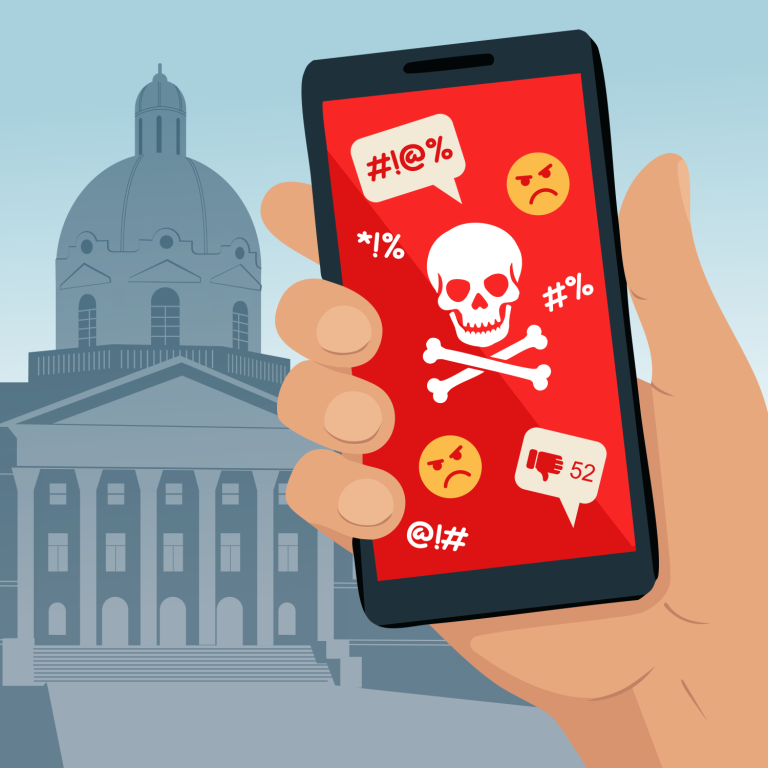
“The person it’s aimed at should know that I know more than I’m tweeting, that I’m actually holding back, that I’m being kind as I try to get a point across,” says Lukaszuk, now the CEO and a partner with Canadian Halal Financial Corporation.
Lukaszuk is in the news these days for his Forever Canadian campaign and provincial referendum initiative. It aligns him against a contingent of Albertans who in the past may well have supported the Progressive Conservatives, back when it was the dominant party in a right-leaning province.
But even in the stormy waters of Alberta’s renewed conversation about separation, Lukaszuk does his best to keep things from being uncivil or extending beyond the issues.
And foul language? That’s a hard no in the tiny part of the social media universe he can control — his own image and voice.
THE STATE OF THE SOCIALS
Not so careful or self-restrained are incalculable numbers of others, including — in a bizarre testament to the times — the president of the United States. Their negative effects and often outsized influence on elected officials and democracy itself are only starting to be measured and understood.
Trolls, bullies, robots, liars, propagandists and other bad actors regularly flood social media with abusive content. In a never-ending tsunami of videos, images, emojis and words, our devices hammer us via a communications system that barely existed three decades ago.
Don’t expect the situation to get better any time soon, says Alex MacIsaac, senior research coordinator with the Samara Centre for Democracy. “Recent changes in digital platform trust-and-safety approaches indicate that the state of social media will continue to worsen,” he says.
Self-regulation from major players is limited at best and their processes are often opaque. Several platforms have changed community guidelines to remove user protections, and Samara has also noted layoffs of “massive portions of their trust-and-safety departments,” MacIsaac says.
Cofounded by Alison Loat and Michael MacMillan in 2007, Samara bills itself as Canada’s leading non-partisan organization focused on strengthening and protecting Canadian democracy. Among its initiatives is a machine learning tool called SAMbot that sorted tweets by specific words on specific accounts during recent election campaigns in Canada, including Alberta’s 2023 provincial general election.
SAMbot focused on what used to be called Twitter, renamed X under Elon Musk. But a new Samara project called VERIFIED used during the recent federal election looked at data from YouTube, Reddit and Bluesky. It also expanded its scope from abuse and toxicity to examine other harms, like disinformation, foreign influence and inauthentic engagement.
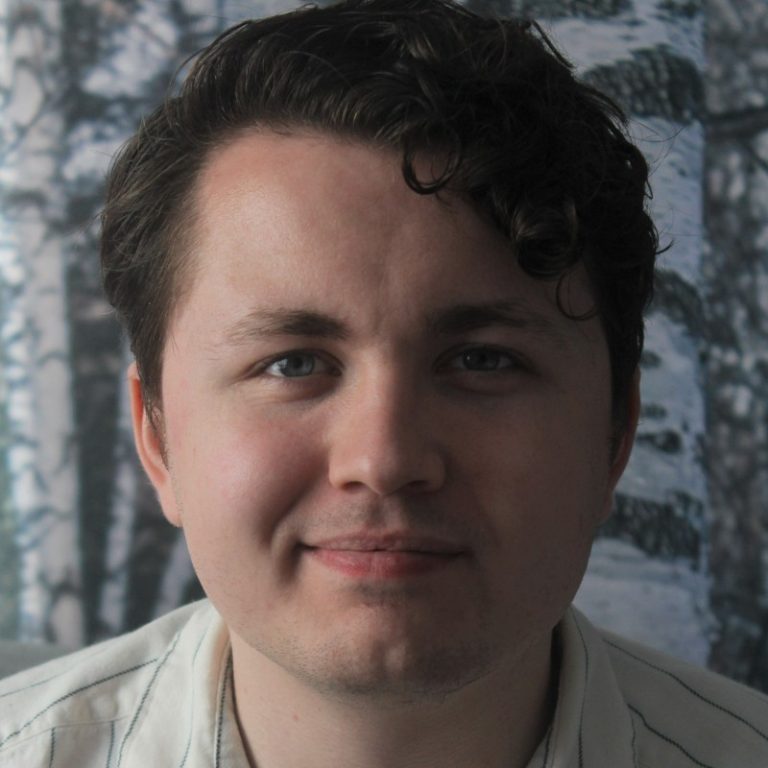
Samara is also “actively working to find other methods that will permit us to collect data from other major platforms like Facebook, Instagram, TikTok and others, helping us paint a broader and better picture of Canada’s social media ecosystem,” says MacIsaac.
But here’s the rub. “The largest challenge we’ve faced as researchers on this topic is access to social media data,” MacIsaac asserts.
“Major platforms have always been largely uncooperative with civil society’s appetite for access to even simple social media data, and in recent years platforms have become even more restrictive in terms of what’s accessible and who can access data from them for public interest research.”
Canada’s Library of Parliament says that abuse directed at politicians on social media is common during federal elections. In 2019 researchers classified nearly 40 per cent of tweets directed at candidates as uncivil and 16 per cent as abusive, reported the library’s official blog, HillNotes.
The blog is tasked with highlighting documents and research to identify findings and trends significant to Parliament’s future.
Tweets directed at candidates in the 2021 federal election were “insulting, hostile or rude” 20 per cent of the time, HillNotes said. Of those, 37 per cent were likely to include profanities or threatening language.
What Samara learned during the 2025 federal election is also eye-opening, as outlined in five reports on its website.
Among abusive comments in the r/Canada subreddit in the first few days of the campaign, the fifth most common word was “Trump.” The fourth most common was “stupid,” and the top three were expletives.
The most referenced people in the subreddit were Mark Carney, Pierre Poilievre, Donald Trump and Alberta’s own Danielle Smith.
RISE OF THE POWER USER
Also of note: small numbers of users had outsized influence.
Just 150 active commenters on r/Canada accounted for at least 14 per cent of all comments during the intake period. And a mere nine users were responsible for 28 per cent of the posts.
Says the report: “This means that only a handful of users are directing the tone and shaping the conversation. From our previous research, we believe this is a trend that occurs across social media platforms.”
Indeed, it’s a phenomenon Samara uncovered in the Alberta election, during which so-called power users skewered tweet numbers away from being a reliable measure of public opinion. Of the tweets collected over 17 days leading up to the election, 12 per cent originated from just 50 accounts.
But SAMbot found that only four per cent of tweets within the accounts it tracked during the election were abusive.
“Four per cent being abusive may seem low, but it’s important to remember that the kind of abuse we’re capable of monitoring does not fully encompass the forms of online harms common on social media,” says MacIsaac.
SAMbot tracked 188 accounts, including seven official party accounts and 181 candidate accounts. Candidates from nine political parties were represented, as well as four independents.
During the tracking period SAMbot monitored 300,861 tweets, of which 12,502 were abusive. Tracked candidates were mentioned 387,792 times, and of those mentions, 15,376 contained abusive content.
The comparative reach of tweets wasn’t tracked. “It’s possible that some or many of these abusive tweets received far more or less engagement than your average neutral or constructive tweet,” says MacIsaac.
Of the top 20 candidates in terms of the number of abusive tweets received, eight were first-timers.
Astroturfing was an issue, too. That’s when posts are part of a campaign to present one viewpoint, often through fake or artificially generated engagement.
In its SAMbot report on the election, Samara concluded that “negative, harmful and manipulative” tweets amounted to threats to democracy. “They increasingly make politics less accessible to ordinary citizens and frustrate attempts to foster productive and pro-democratic dialogue.”
F-BOMBS AND MORE
But you don’t have to be a major research organization to understand that social media and politics have a dysfunctional relationship. Anyone with the internet and a search engine can find abusive and threatening content attached to major names.
When Lukaszuk tweeted that it’s “time to shut that down” in reference to separatism in Alberta, one commenter responded: “Canada is a socialist [expletive]and you can [expletive] off.”
Another time on X, the former Twitter, Lukaszuk was called “fascist scum” for comments about two Freedom Convoy participants.
Meanwhile, sitting members in Lukaszuk’s old haunt deal with a barrage of online abuse, regardless of their side of the floor. Those MLAs who interact with the masses online sometimes read their names attached to expletive-laced descriptors, often within ideological or hate-filled rants.
Members of the LGBTQ-plus community, along with anyone who stands up for them, attract spikes in abusive commentary, multiple studies have noted.
Ticking both those boxes is Brooks Arcand-Paul, a gay man who supports the community from his seat in the legislature as the NDP member representing Edmonton-West Henday. He also happens to be Indigenous, another fact of his identity that attracts abuse.
On Reddit, a legacy post calls Arcand-Paul a pile of excrement. He’s also been called a cuck – a derogatory short-form of cuckhold that’s taken on an online life of its own. And he’s been told on Reddit to “get stuffed.”
Posts like those take a personal toll, says Arcand-Paul. Threats, dehumanization and expressions of anger can be emotionally devastating, especially when they combine with the ups and downs of a target’s personal life.
But he insists he was not naïve about what lay ahead when he decided to run for office.
He remembers schoolyard banter in Morinville, near his home community of Alexander First Nation in northcentral Alberta.
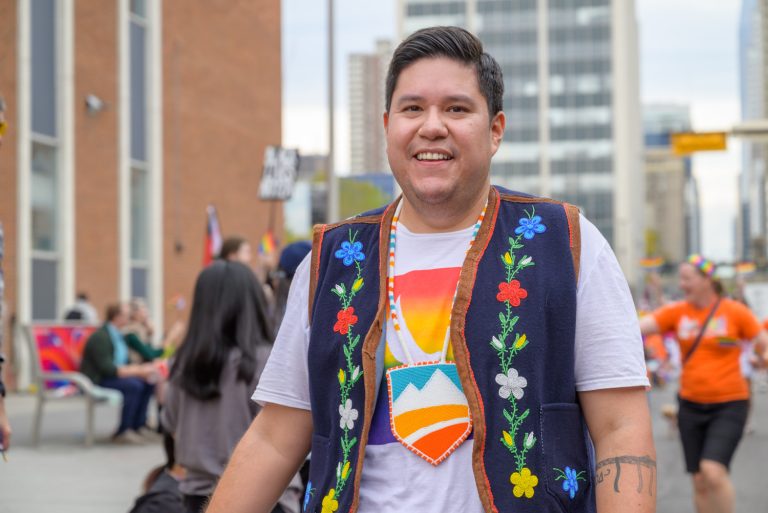
“I was not, you know, misled,” says Arcand-Paul, the NDP’s critic for Indigenous relations. “I knew racism and homophobia were omnipresent in interactions, in jokes, in off-the-cuff remarks. But it was never direct. It was never hurtful. And it was never like there was violence attached to it.”
Inspired by the rise of former premier Rachel Notley and the NDP, Arcand-Paul relocated his emerging legal career from Toronto in 2017. The University of Alberta graduate had finished law school in Ontario and articled with the province’s Ministry of the Attorney General.
Before seeking office in Alberta, he entered private practice. Twice he worked directly as counsel for individual First Nations, one of them his own.
And he ran successfully in Alberta’s 2023 general election.
One stretch of public derision over a statement he made in the legislature meshed with private pain — a cousin had been shot dead by police — to put him “in a really dark place,” Arcand-Paul admits. The noise was amplified by mainstream media stories and opinion pieces.
So he closed his X account. Today, support staff assist him in monitoring posts and shielding him from the more egregious comments that make the digital rounds. To protect himself, his friends and his colleagues, he carefully curates the platforms he does use.
Among the people he turned to for advice was Janis Irwin, an NDP colleague more experienced in public life.
Queer and female, Irwin doesn’t shield herself from the digital world, where her feeds are a mix of her private and public personas.
“I love telling other politicians and people getting started, don’t do what Janis Irwin does,” quips the provincial member for Edmonton-Highlands-Norwood, “because I do my own social media.”
AS SEEN ON TV?
Those Albertans who do vibe with Irwin also see her regularly on mainstream TV, the perfect place to learn all about her everyday life, her thoughts on public policy, the events she attends and the causes she supports.
Right?
Wrong.
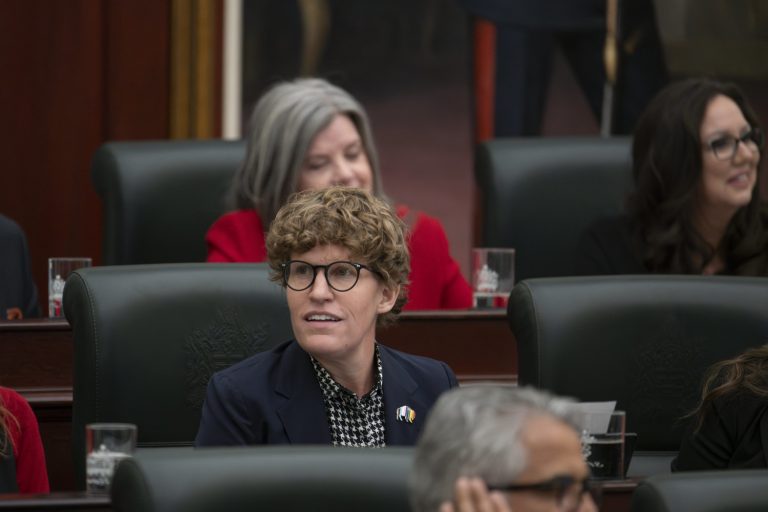
That’s not how things work for Irwin’s audience, even though some news consumers may not realize it. The NDP’s deputy whip in the Alberta legislature, Irwin reaches some 72,000 followers on Instagram, more than 46,000 on TikTok and more than 48,000 on Facebook.
Like many of those followers, the former teacher and school administrator from rural Alberta has a deeply ingrained digital life. Social media is part of who she is and how she connects with people, whether they’re voters, allies, foes, friends and family, the LGBQT-plus community, some blend of the aforementioned or some other subset of humanity.
Members of the public often tell her they’ve seen her on TV. “The reality is, I’m not on TV all that much,” she says.
“People see me on whatever platforms they’re on,” explains Irwin, the NDP’s housing critic. “And that’s kind of equated with regular media for a lot of folks.”
On the elder end of the millennial demographic, Irwin gets it. And she maintains that her authentic and relatable voice is something that, so far, she doesn’t want to give up. “Maybe a few staff members look at my posts sometimes and shake their heads, but it is what it is.”
Like most modern public figures, Irwin knows social media needs to be among her messaging tools. After all, 60-plus per cent of the global population use various platforms to connect with their real-world and virtual friends and communities.
PERVASIVE AND PROFITABLE
Indeed, social media and similar platforms are nearly inescapable in today’s media landscape. Still popular are old-timers like YouTube, Facebook, Instagram, LinkedIn, Snapchat, Reddit and the former Twitter. Also out there are relative newcomers like TikTok (almost 10 years old) and the even younger Bluesky, which was launched as a friendly and thoughtful option.
Meta alone, the publicly traded company that owns Facebook and Instagram, recorded revenues of US$164.5 billion in 2024, up nearly 22 per cent from the year before. Nearly $135 billion of that was in advertising revenue.
Even after expenses are considered, Meta is extremely profitable, with net income in 2024 of more than US$62 billion.
Alphabet Inc. is the company that owns Google, YouTube, Waze and others, along with subsidiaries involved in robotics, drone-based freight delivery, health and wellness, sustainable agriculture and more. It’s publicly traded, too, and even more profitable than Meta.
More than US$350 billion landed in Alphabet’s coffers in 2024, and net income was more than $100 billion.
Clearly, people love their social media. Roughly eight in 10 Canadians are users, studies say, with an average daily time spent on social media across the population of about two hours a day.
That’s somewhat lower than the global average of about 140 minutes a day. But also interesting is that young people are generally on social media way more often than their elders. A study referenced by the Canadian Paediatric Society, for example, suggests 20 per cent of high school students in Ontario and Alberta spend five or more hours a day on social media.
Why such love? Experts and studies have identified reasons for society’s social media infatuation.
Personalized algorithms validate users and reinforce belief systems through the content pumped into their feeds. These often limit competing ideas and, in some cases, push users towards extremism. And dopamine hits keep users coming back for likes and comments.
TROLLS WILL BE TROLLS
Within all that scrolling, liking, smiling and ranting, poor behaviour is probably here to stay.
So says Irfan Chaudhry, a lecturer and hate researcher with MacEwan University in Edmonton. He’s also the university’s former director of human rights, diversity and equity.
“Unfortunately, some actors enjoy trolling on social media. They feel there’s an element of power that maybe they don’t perceive in the offline world,” he says. “So I don’t think that’s something we can regulate away. You’re always going to have bad actors in some of these contexts.”
Hate exists in the real world, and the internet plays a role in triggering it. But it also helps generate support for tolerance, Chaudhry notes.
In Ajax, Ont., a Muslim woman wearing a hijab was studying in a public library earlier this year when a stranger poured a fluid, likely an accelerant, on her hijab. Fortunately, the assailant’s lighter didn’t work.
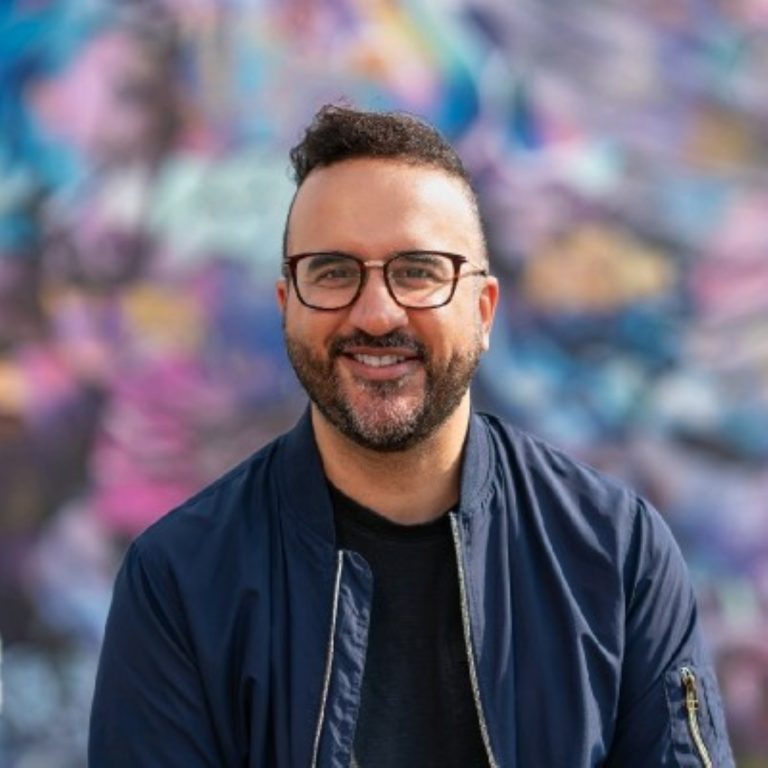
“You’re seeing a lot of things like that when you talk about the impact of social media, but I also think the awareness of the impact is more amplified on social media.”
Support for the woman, after all, rang out across traditional and social media.
Chaudhry also thinks big players have taken positive steps in self-regulation, as well as some notable steps backwards.
The purchase of Twitter by Musk has made X “a really bad space for everyone, regardless of their political stripes, to engage on, just because it’s less moderated now.”
LIVING WITH THREATS
Janis Irwin, for one, noticed the tenor change at X. Gradually over the last decade or so, she’s built a following on multiple platforms in her provincial and public roles. But she rarely posts on X anymore.
Before her election in 2019, Irwin worked in government and later for Rachel Notley, who was then the leader of the NDP and the premier. In 2015 she’d sought a federal seat, finishing second to the Conservatives in Edmonton Griesbach.
Her following and reach grew, and Irwin learned to cope with attacks by blocking accounts and deleting comments. She chooses not to engage with trolls, who probably can’t be won over to her point of view anyway.
To the sergeant-at-arms of the legislature, Irwin regularly reports threats she receives, whatever pathway her haters choose.
The Alberta legislature doesn’t release threat data, and under freedom of information and privacy legislation its staff can’t be compelled to do so. But threats and abusive communications against Notley did become a matter of public record while she was premier.
Notley was, in fact, the most threatened premier in Alberta’s history during her time at the helm. She received 412 harassing communications, Alberta Justice reported in 2016, and 16 of them were investigated by law enforcement. In the last half of 2015 there were 19 security incidents registered against her.
Another popular target is Naheed Nenshi, the NDP’s current leader. Nenshi has been heralded for his ground-breaking use of social media and innovative marketing to reach voters, especially younger ones.
The approach is widely credited with making him the first Muslim mayor of a major Canadian city when he was elected in 2010. Nenshi left the top elected position with the City of Calgary on his own terms when he bowed out in 2021.
Twitter once held the promise of becoming a platform to engage in constructive discourse, Nenshi wrote in Politico in 2021. But things changed.
“Today, social media is an anti-social battleground for unfiltered, post-truth put-downs and provocations,” he noted in his Politico piece. “Whether I post about politics or a lost puppy, I can count on receiving vitriolic, racist and personal attacks.”
Like Nenshi, Irwin deals with the good, the bad and the ugly of social media. The online world “can certainly be overwhelming and disheartening at times,” she notes.
“But you know, there’s a need for hope and queer joy, as we call it. So finding hope and joy wherever you can is necessary.”
For some, that’s online. For others, it’s out in the real world at community events. Or perhaps it’s a mix of both.
Maintaining mental health is “tough for a lot of people these days,” she says. “So just doing what we can to build community: that’s what’s important to me
THE PRICE OF BEING IN POLITICS
But regardless of the identifiers attached to them and where they are on the political spectrum, those in public positions are widely considered fair game. After all, they’ve got messaging they’re compelled or obligated to share in the messy, noisy town square of our times.
Adriana LaGrange of the UCP, who once had a rock thrown through the window of her Red Deer-North constituency office, is a former education minister and now the minister of primary and preventative health services.
“Address the measles crisis, you [expletive] idiot” is a recent X reply to a LaGrange post.
Said another X user: “You are vertically and mentally challenged. Just resign.” (What LaGrange’s height has to do with anything wasn’t made clear.)
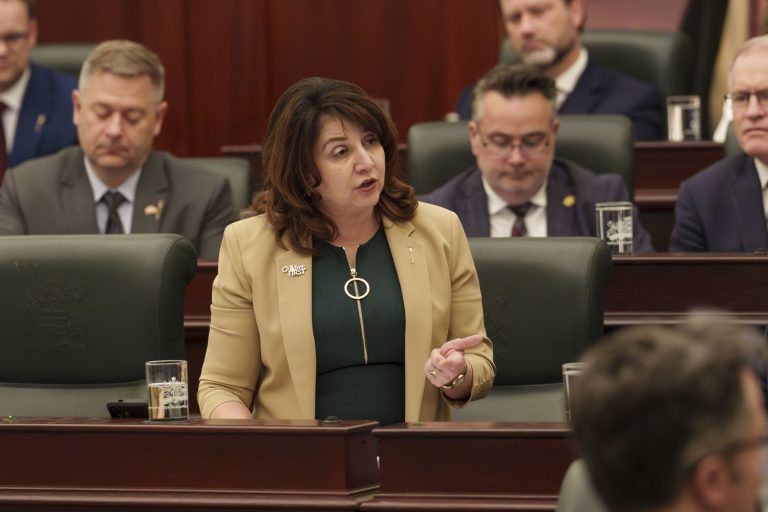
Another comment hints at personal repercussions for LaGrange because of her handling of health care. “Life has a funny way of evening things out you ghoul.”
Replying to a LaGrange tweet about seeking input from health workers on branding a new provincial health corporation, an X user wrote: “Can you just [expletive] off already grifter? You will go down in history as. . .”
You get the picture.
LaGrange’s office did not respond to multiple requests for an interview for this story. In fact no elected members of the UCP agreed be interviewed, after the paper made requests to specific members and an overall request through the premier’s office.
Irwin of the NDP has been called a nutjob, a narcissist and a groomer. That last one is a term for someone who prepares children for being lured into having sex with adults. It’s often used to perpetrate the myth that those who celebrate their LGBQT-plus identity are society’s biggest source of pedophiles. (Spoiler: they aren’t.)
Despite the toxic online environment, a lot of politicians choose to post and scroll with the rest of us. After all, it’s a nearly essential way of reaching voters, gaining support, gathering feedback and explaining policy.
Democracy, in other words, relies upon it.
A TWEET TOO FAR?
Yet ironically, many experts, pundits and everyday citizens think online anger, hate and lies have gone so far that social media threatens the foundations of the very democracies it supposedly upholds.
Or maybe politicians just need thicker skins, goes one line of thinking. Afterall, elected representatives in every era have dealt with mockery, going back to the times of Dickens and Swift and earlier. Modern cartoonists continue to regularly skewer elected officials.
The media change with the times. But accepting derision always goes with the territory.
The argument is most pointed after politicians and government agencies choose to block specific commenters or turn off comments entirely.
In a December 2017 article in an online magazine called The Conversation, two York University adjunct professors in administrative law called blocking commentors “a troubling trend (that) has serious implications for freedom of expression.”
Wrote Justin Safayeni and Andrea Gonsalves of the Toronto university: “This is the paradox of social media as a tool for political dissent: exercising freedom of expression is easier than ever before, but so is censorship.”
The duo acknowledged that there are limits to what should be said.
“Social media can certainly be a breeding ground for racism, harassment, defamation and other vile speech that does little to contribute to the marketplace of ideas.”
That means officials or government agencies “might properly block such communications without breaching” Canada’s Charter of Rights and Freedoms, the article says.
But what if abuse drives politicians out of office, stops potential candidates from seeking election in the first place, or stops citizens from even entering that esteemed marketplace of ideas?
Anecdotal examples of exactly that effect abound. If they do represent a statistically significant trend, democracy will suffer, many social media watchers believe.
A female Liberal MP from Ontario didn’t run again in the last election specifically because of social media and its effects.
“Unfortunately, the toxic drive for social media likes and clips among elected officials has hindered constructive conversations, exacerbated difference between us and diminished our capacity to show empathy towards each other,” Pam Damoff, who represented Oakville North-Burlington, posted in the spring of 2024.
“The threats and misogyny I have experienced as a member of Parliament are such that I often fear going out in public, and that is not a sustainable or healthy way to live.”

Once during his time as minister of labour, Lukaszuk had to protect himself and his family against threats.
He alarmed his house and had an RCMP detail assigned to him. His wife carried a pager in her purse, a direct line to the police. A journalist published his licence plate number and home address, and even made comments about where his daughter went to school.
Lukaszuk had the windows in his government car tinted, at a cost to taxpayers of about $400. “Google Thomas Lukaszuk tinted windows,” he says. “The media tried to make a controversy out of it, but when they realized why I did it, they didn’t have an issue.”
He continues: “Thankfully, in my situation, none of the threats came to any realization. But I know that the world out there for politicians right now is much more volatile than it even was 10 years ago.”
Says Chaudhry, the hate crime researcher: “We lose a lot, if we’re only having a homogenous group put their hands up to lead in public service.”
He continues: “And those who are in office sometimes choose to stay off or not engage in social media. So we lose in that way, too, because they miss out on an opportunity to engage with constituents.”
THE NOISY AND THE MANY
Assuming MLAs in Alberta are like the rest of the world, most are, at minimum, somewhat connected to the larger conversation via a platform or two.
A commonly accepted estimate is that 4.8 billion people worldwide use social media, which is close to 60 per cent of the population. In an aggregated 2024 report on social media’s popularity, Online Business Canada pegged Alberta’s usage at 57 per cent.
Literally billions of posts are made worldwide each day across major platforms. One estimate for X is 500 million posts a day.
Over on TikTok, 34 million videos drop each day, according to the digital agency Social Shepherd.
Instagram users, meanwhile, are impressing followers with depictions of their awesomeness at a rate of 1.3 billion photos and videos a day, say several companies that collect and analyze social media data.
Using the numbers from those three platforms alone, that’s a staggering 21,000 posts per second.
The Samara Centre for Democracy, which believes in responsive institutions and an engaged public, is one of the organizations trying to make sense of the noise.
In 2021, Samara’s CEO Sabreena Delhon wrote on the organization’s site: “At its best, social media is a powerful tool to improve our democracy, providing a way to hold politicians to account, share information and express ideas as well as disagreement. For those seeking office, social media has become a vital tool to manage and execute campaigns — a way to connect with constituents, demonstrate authenticity and convey positions.”
But the destructive power of social media is a major Samara concern, she said.
Social media has been “weaponized to deliver abuse and incite violence,” Delhon wrote, with malicious users of social media creating divisions, diminishing equity in politics and spreading disinformation, which is typically defined as information known to be false and designed to mislead.

“It’s time for a digital democracy detox. Online toxicity in political spaces is sending a signal about the strength of our democracy,” Delhon concluded. “This is a major problem of our era and solving it requires approaching voter engagement and election campaigns in new ways.”
HOW ABOUT SOME REGULATION?
Delhon’s “problem of our era” also requires government regulations pointed directly at social media. At least that’s a stance Samara takes unequivocally.
Perhaps a starting point for that argument is finding common ground on just how miserable social media can be.
Some days it seems that cyberspace is just one hate-filled conspiracy theory after another, followed by a string of libelous comments and mean-spirited memes. If you posted that sentiment within an attention-grabbing meme or a pithy joke, much of your scrolling audience would likely nod in agreement.
Some would even slap you a heart or a thumbs-up — hello dopamine.
But watch your rate of likes tumble as soon as you sprinkle in nuance. Because when it comes to their relationship status with social media, Canadians tick the “it’s complicated” box.
Government regulation is a case in point.
Back in March 2024, two-thirds of a Leger poll’s respondents supported a federal plan to make social media platforms safer. But when asked about balancing the proposed law with adequate free speech protections, about half the respondents didn’t trust the feds to get it right.
And the results indicated that a significant minority — 43 per cent — in one province, Alberta, thought the government’s plan would fail in two critical areas: making the platforms safer and making the removal of sensitive content easier.
Popularity of the federal Liberals and Justin Trudeau hovered around 25 per cent in March 2024, which almost certainly influenced the results. And the poll of 1,527 Canadians aged 18 or older was not wholly random, drawing on participants from a pre-existing panel.
Regardless, regulations are needed, says Samara’s MacIsaac. “Broadly in Canada, we don’t have regulations that work to curb online harms,” he says.
And it won’t be easy. Policymakers “face the challenge of attempting to regulate a host of foreign firms that are among the largest and most powerful in the world,” he says
Irfan Chaudhry, the hate speech researcher, hasn’t given up on social media’s ability to regulate itself and moderate content.
“The protection of users of social media is a lot better than it was, through things like verified and legitimate users,” Chaudhry says. “Politicians and even municipalities have safeguards in place now. When they post something they know is going to be contentious, they have the power to turn off comments and block specific users.”
Chaudhry agrees that politicians who use social media to engage with their constituents “receive a high volume of volatility,” noting it’s especially true for female, racialized and left-leaning politicians.
And he finds it troubling that some platforms are shifting away from effective moderation.
“We don’t accept a lack of moderation offline, so I’m not sure why we accept it online. We spend a lot of our lives engaging in online spaces. So there’s a bit of a disconnect that these platforms have with their responsibilities.”
Which leads the conversation back to regulation.
Says MacIsaac of Samara: “We believe that through regulation and investment in domestic digital public infrastructure, we can have safer, productive, collaborative and pro-social online environments that support democracy and civic engagement rather than work against them.”
THIS ACT, THAT ACT, THAT OTHER ACT
Several pieces of legislation, proposed or otherwise, do come up when you talk about regulating social media in Canada.
The law most applicable was heading towards approval at the time of the Leger poll. The Online Harms Act — or more correctly Bill C-63, because it never was enacted — dug deep into regulating social media.
The far-reaching bill demanded accountability, action and transparency. It would have created a digital safety bureaucracy with an ombudsperson, an office and a commission. It would have promoted online safety, defined harmful content and strived to protect children and other vulnerable people.
But Bill C-63 died with the dissolution of Parliament before the last federal election. And now the new prime minister is focused on other matters.
Two existing laws regulating cyberspace — the Online News Act and the Online Streaming Act — could yet fall victim to trade talks. Afterall, the fledgling three per cent digital services tax has already disappeared under Carney’s dealings with Trump.
Whatever direction the government chooses, fears persist that more regulation would mess with legitimate messaging and diminish the online experience.
More critically, the Canadian Civil Liberties Association framed Bill C-63 as a constitutional threat because of its provisions surrounding hate speech, hate motivation and maximum sentences. The CCLA warned in its testimony before a House of Commons standing committee that the bill would result in a “chilling effect on free speech and an unwarranted increase in plea bargaining from innocent and vulnerable defendants.”
Indeed, many social media users and researchers view the platforms as indispensable tools in a modern democracy. And society may well adapt to social media over time.
MacIsaac qualifies his support this way: “Social media, as a concept, has immense power to connect, share knowledge, inform, and give voice to and reach many who otherwise wouldn’t have access to a platform. The problems we’re experiencing with digital platforms aren’t the concept or technology of social media. The problems are execution and incentives.”
Chaudhry, meanwhile, says that “better literacy on how to use the platforms” is emerging, particularly in younger Canadians.
“We’ve adapted in the past,” he says, pointing to how people act when they talk on the phone and how the technology evolved for blocking and identifying callers.
“I think what makes it a challenge right now is the scope and volume and size of the various social media platforms,” says Chaudhry. “And people do have an appetite to engage on unregulated platforms.”
A DOUBLE-EDGED SWORD
Those negative and positive facets of social media are what one meta-analysis calls a “dual-use dilemma.” The peer-reviewed paper says it’s an “inescapable fact that technologies can be used for both noble and malicious aims.”
The authors from Germany’s Max Planck Institute for Human Development, writing in Nature Human Behaviour in November 2022, compared the impact of the digital space today with that of an older technology in the 20th century: the radio.
Nazis used radio to spread hateful propaganda during the Second World War. But the BBC used it to support the Resistance by sharing tactical information, wrote the authors of A Systematic Review of Worldwide Causal and Correlational Evidence on Digital Media.
Five decades later in Rwanda? Same technology, different genocide.
Radio messaging incited Hutus to massacre the Tutsi minority, the researchers wrote. But in the genocide’s aftermath, a radio soap opera reduced intergroup prejudice.
“Digital media appears to be another double-edged sword,” says the paper.
It can empower citizens, like it did during the Arab Spring and the #MeToo movement. But it can also be “instrumental in inciting destructive behaviours and tendencies such as polarization and populism, as well as fatal events such as the attack on the United States Capitol in January 2021.”
The study, which relied on 496 research articles, acknowledged the complicated nature of drawing conclusions from mountains of social sciences data. Real-world evidence isn’t as straightforward as what you’d eyeball in petri dishes during carefully controlled studies in the lab.
And as science communicators regularly tell their audiences, correlation does not equal causation.
But the analysis found “grounds for concern,” the authors wrote. Along with positive effects on democracy, there’s “clear evidence of serious threats,” their conclusion says.
“Considering the importance of these corrosive and potentially difficult-to-reverse effects for democracy, a better understanding of the diverging effects of digital media in different political contexts. . .is urgently needed.”
ANOTHER EUROPEAN PERSPECTIVE — FROM AN ALBERTAN
Faced with dire indicators and warnings like that, some say things have gone so far it’s too late. But not former politician Thomas Lukaszuk.
“Am I pessimistic? I’m not pessimistic. But I am extremely aware of what’s going on.”
Lukaszuk’s take on tyranny is deeply personal. “I was a kid that woke up at the age of 11 and went outside when martial law began in Poland, and we had tanks and armoured vehicles out there, and I had machine guns aimed at me. I lived through people dying in the streets and getting tear-gassed by police. That is what being scared is, that is what being worried is.”
Even though he’s an active participant in online discussions, the former deputy premier does not dismiss this moment and its power to undermine democracy.
In his heart Lukaszuk holds stories passed along by his grandparents and great grandparents, as they reflected on two world wars from the European perspective.
“What we’re seeing right now is a reoccurrence of 1932 and ’33. It’s a buildup of nationalism, a buildup of fascism, a buildup of populism. And much like Germans and Italians and others during that time used the propaganda and technology available to them, that is what’s happening now,” Lukaszuk says.
It’s a dangerous trend leveraged by social media. The actors and their stages may be different, but “frankly, the language and the mechanics are exactly the same.”

